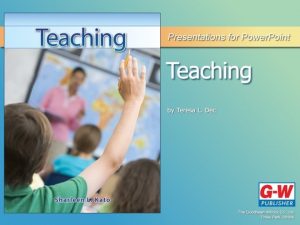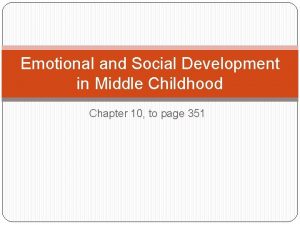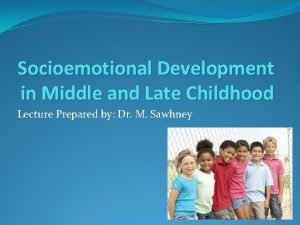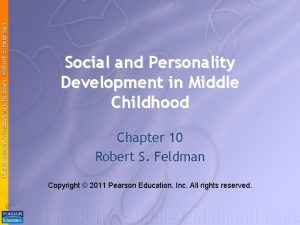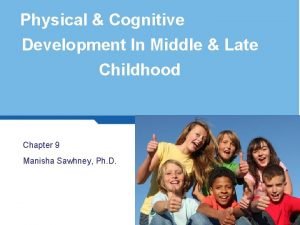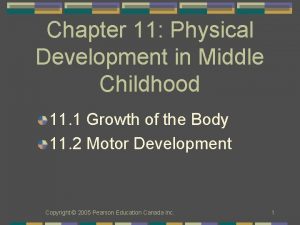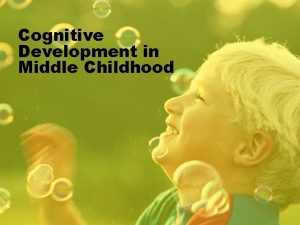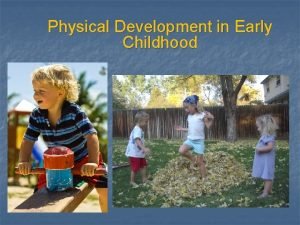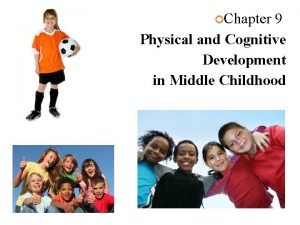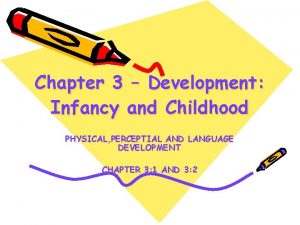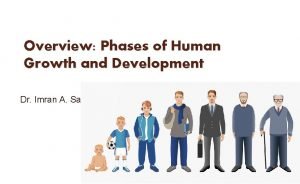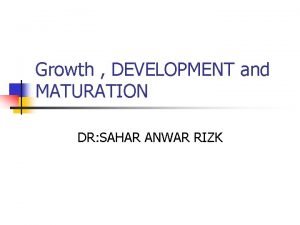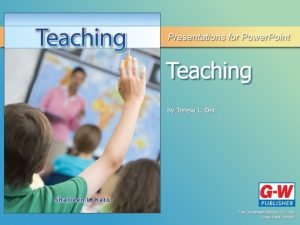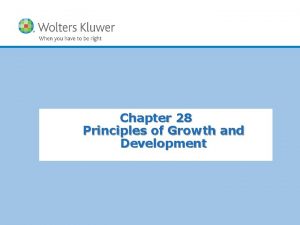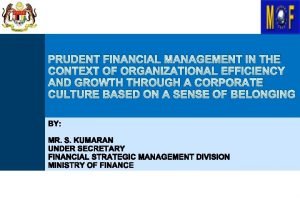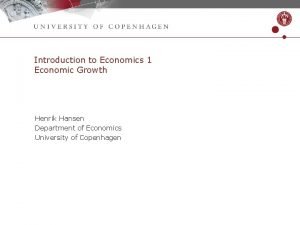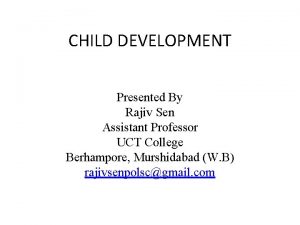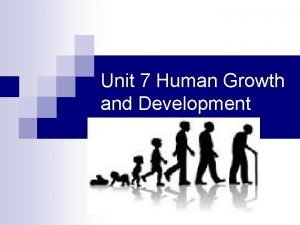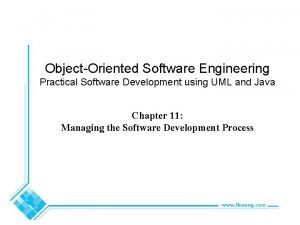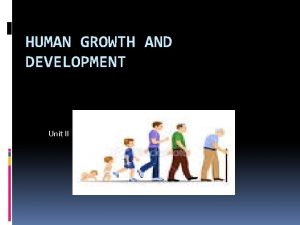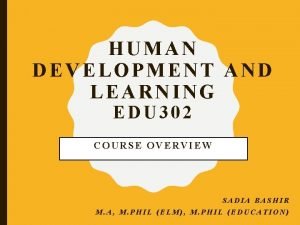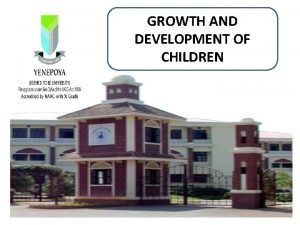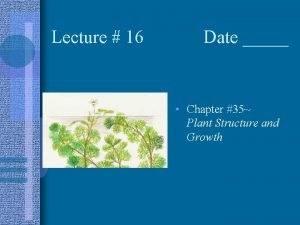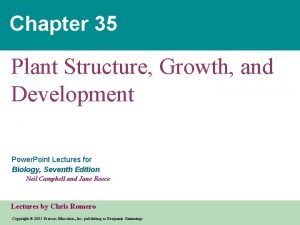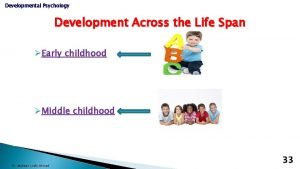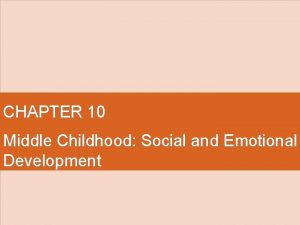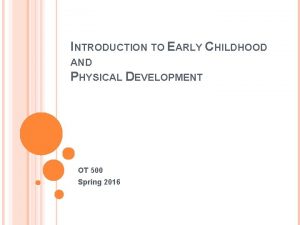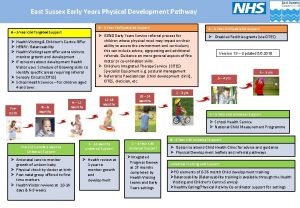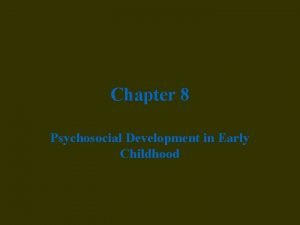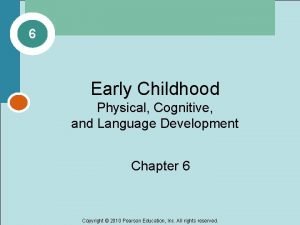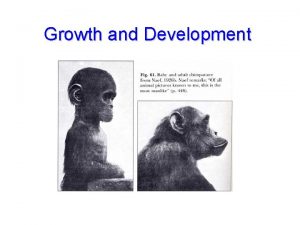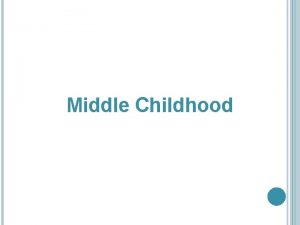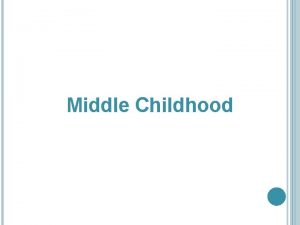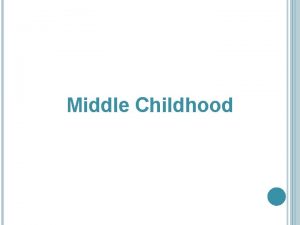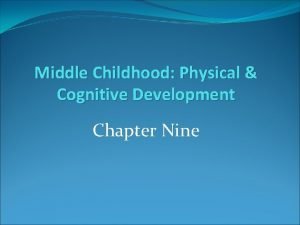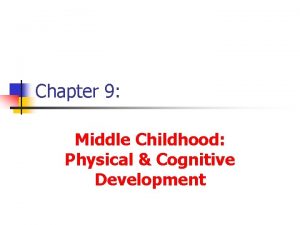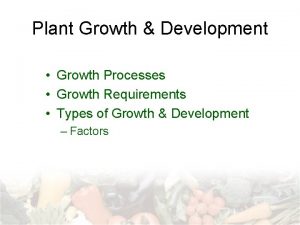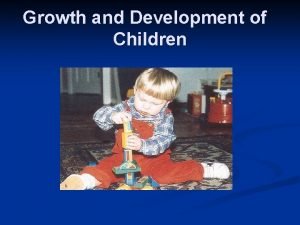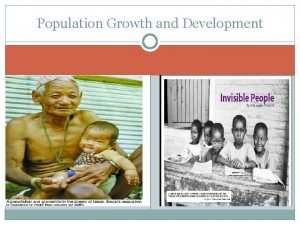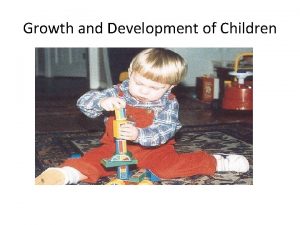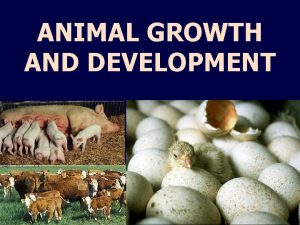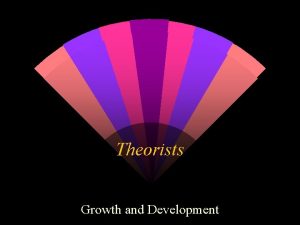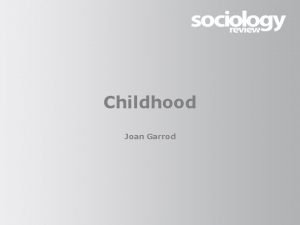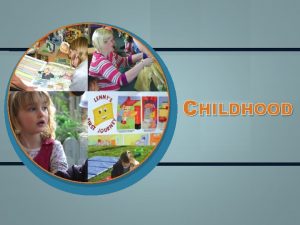4 Middle Childhood Growth and Development Middle Childhood


























































- Slides: 58


4 Middle Childhood: Growth and Development

Middle Childhood: Growth and Development • First years of school are crucial for children • Development follows predictable patterns • Information about development is based on averages • Slight variations are normal, but developmental delays should be identified and treated continued © Goodheart-Willcox Co. , Inc. Permission granted to reproduce for educational use only.

Middle Childhood: Growth and Development Stage/Age Erickson’s Psychosocial Theory Infancy Trust vs. mistrust Toddler Autonomy vs. shame and doubt Early childhood Initiative vs. guilt Middle Industry vs. childhood inferiority Piaget’s Cognitive Theory Sensorimotor Preoperational Concrete operational continued © Goodheart-Willcox Co. , Inc. Permission granted to reproduce for educational use only.

Middle Childhood: Growth and Development Stage/Age Erickson’s Piaget’s Psychosocial Cognitive Theory Adolescence Ego identity vs. ego Formal diffusion operational Young adulthood Intimacy vs. isolation Middle Generativity vs. selfadulthood absorbtion Older adulthood Integrity vs. despair © Goodheart-Willcox Co. , Inc. Permission granted to reproduce for educational use only.

Objective • Explain the importance of readiness for learning for children entering kindergarten. © mypokcik/Shutterstock © Goodheart-Willcox Co. , Inc. Permission granted to reproduce for educational use only.

Beginning School • Most children start school around age 5 • In a kindergarten class, there may be significant differences between the oldest and youngest students • Early school years are crucial to brain development and school success • Full-day kindergartens may provide a smoother transition to first grade continued © Goodheart-Willcox Co. , Inc. Permission granted to reproduce for educational use only.

Beginning School • Kindergarten readiness skills include – gross-motor skills – fine-motor skills – self-help skills – cognitive skills – social-emotional skills © Goodheart-Willcox Co. , Inc. Permission granted to reproduce for educational use only.

For Discussion • What do you remember most about your activities in kindergarten? How did these affect your feelings about school? © Michael D. Brown/Shutterstock © Goodheart-Willcox Co. , Inc. Permission granted to reproduce for educational use only.

Objective • Trace the growth pattern of children during middle childhood. © Stuart Monk/Shutterstock © Goodheart-Willcox Co. , Inc. Permission granted to reproduce for educational use only.

Children Ages Five to Seven • Children of this age – are talkative – are imaginative – love to explore – crave adult approval – can be sensitive – can be cooperative yet competitive © Goodheart-Willcox Co. , Inc. Permission granted to reproduce for educational use only.

Objective • Analyze the physical and cognitive skills required to master a task. © Anatoliy Samara/Shutterstock © Goodheart-Willcox Co. , Inc. Permission granted to reproduce for educational use only.

Physical Growth and Development • Growth in height and weight slows during this period, with an average of – 2 3 inches per year – 4 5 pounds per year • Bodies look longer and leaner • Baby teeth are replaced by permanent teeth © Goodheart-Willcox Co. , Inc. Permission granted to reproduce for educational use only.

Gross-Motor Skills • Better developed than fine-motor skills • Physical skills makes them feel independent • Full of energy to run, jump, skip, hop • Activities improve balance and coordination • Fearlessness may result in accidents • Visual-motor coordination improves © Goodheart-Willcox Co. , Inc. Permission granted to reproduce for educational use only.

Fine-Motor Skills • Hand-eye coordination improves • Dexterity improves • Writing skills are a combination of cognitive and physical development • Cutting, coloring, building, and playing electronic games all develop fine-motor skills • Self-care depends on fine-motor development © Goodheart-Willcox Co. , Inc. Permission granted to reproduce for educational use only.

Objective • Link children’s thinking skills at various ages to Piaget’s stages of development. © tan 4 ikk/Shutterstock © Goodheart-Willcox Co. , Inc. Permission granted to reproduce for educational use only.

Cognitive Development • Children are – eager to learn – excited about starting school – curious and excited for independence • They also – have limited attention spans – learn better through experience © Goodheart-Willcox Co. , Inc. Permission granted to reproduce for educational use only.

For Discussion • How are physical development and cognitive development related at this age? © Michael D. Brown/Shutterstock © Goodheart-Willcox Co. , Inc. Permission granted to reproduce for educational use only.

Thinking Skills • At age five, children are unable to understand conservation • They begin to understand around age seven © Quayside/Shutterstock © Goodheart-Willcox Co. , Inc. continued Permission granted to reproduce for educational use only.

Thinking Skills • Children at this age begin to understand – sequences of steps – a mix of words, logic, and humor • Imagination is still vivid – Allows them to express anxiety and conflict © Goodheart-Willcox Co. , Inc. Permission granted to reproduce for educational use only.

Language and Reading • Children identify letters as symbols • Begin to recognize the sounds they make • Start with letter combinations, then word combinations • By the end of second grade, many are competent readers • Children with difficulties at this stage need extra help © Goodheart-Willcox Co. , Inc. Permission granted to reproduce for educational use only.

Objective • Develop a list of the social skills children must learn. © Darren Baker/Shutterstock © Goodheart-Willcox Co. , Inc. Permission granted to reproduce for educational use only.

Social-Emotional Development • Children develop feelings of competence by learning new skills • Self-confidence grows • They can feel inferior to other children © Goodheart-Willcox Co. , Inc. Permission granted to reproduce for educational use only.

Peer Relationships • Peers become more important • Choice of friends may change often • Form closer one-on-one and group relationships • Girls usually play with girls, boys usually play with boys © Goodheart-Willcox Co. , Inc. Permission granted to reproduce for educational use only.

Family Relationships • Children want to please their parents • They respond well to expectations and rules • Sibling relationships may vary from helpful to arguments © Goodheart-Willcox Co. , Inc. Permission granted to reproduce for educational use only.

For Discussion • Why do you think siblings of this age argue often? © Michael D. Brown/Shutterstock © Goodheart-Willcox Co. , Inc. Permission granted to reproduce for educational use only.

Objective • Explain how the development of self-concept during this period is related to Erikson’s psychosocial theory. © Forster Forest/Shutterstock © Goodheart-Willcox Co. , Inc. Permission granted to reproduce for educational use only.

Self-Concept • Childhood is a critical time for developing self -concept – Positive: act in ways that enhance abilities; feel capable and worthwhile – Negative: adopt self-defeating behaviors • Sense of competence results in self-confidence © Goodheart-Willcox Co. , Inc. Permission granted to reproduce for educational use only.

Moral Development • Children this age can – tell the difference between right and wrong – understand abide by rules – wait for their turn – share toys – express anger and jealousy in competition © Goodheart-Willcox Co. , Inc. Permission granted to reproduce for educational use only.

Children Ages Eight and Nine • Second through fourth grades – Increased skills – Greater knowledge – Better judgment – Increased independence • Eight-year-olds are more easygoing than nine-year-olds © Goodheart-Willcox Co. , Inc. Permission granted to reproduce for educational use only.

Physical Growth and Development • More individual variation than at younger ages • Some may begin puberty at eight or nine • Steady growth continues – Girls have slightly larger gains than boys © Goodheart-Willcox Co. , Inc. Permission granted to reproduce for educational use only.

Motor Skills • Increased strength • Better body control • Physical activities help build stamina and confidence • Hand-eye coordination continues to improve © Cheryl Ann Quigley/Shutterstock © Goodheart-Willcox Co. , Inc. Permission granted to reproduce for educational use only.

Cognitive Development • Learning becomes more complex • May experience a downturn in interest and enthusiasm in learning • Those who fall behind have a harder time catching up later as the pace of learning increases © Goodheart-Willcox Co. , Inc. Permission granted to reproduce for educational use only.

Thinking Skills • Longer attention spans • Improved memory • More complex thinking, including – seriation – classification – conservation – transitivity © Goodheart-Willcox Co. , Inc. Permission granted to reproduce for educational use only.

Language and Reading • Children now focus on meaning – Identify main points – Summarize – Make predictions © Rob Marmiom/Shutterstock © Goodheart-Willcox Co. , Inc. Permission granted to reproduce for educational use only.

Social-Emotional Development • Eight- and nine-year-olds mature rapidly • They can complete more complex tasks, which gives them self-confidence • They begin to be sensitive to criticism © Goodheart-Willcox Co. , Inc. Permission granted to reproduce for educational use only.

Peer Relationships • Want to be part of a group • Have a best friend • Look for acceptance and loyalty • Begin to show empathy and caring • Exclusion from groups may result in bullying problems © Goodheart-Willcox Co. , Inc. Permission granted to reproduce for educational use only.

Family Relationships • Focus shifts outside the family • Children may ignore or argue with parents • Often in conflict with siblings • Need consistent rules and limits © Goodheart-Willcox Co. , Inc. Permission granted to reproduce for educational use only.

For Reflection • Do you recall your family relationships at this age? How had they changed from when you were younger? Why do you think this was the case? © Archipoch/Shutterstock © Goodheart-Willcox Co. , Inc. Permission granted to reproduce for educational use only.

Self-Concept • Children at this stage want to feel – a sense of belonging – that they are competent • They are still full of doubts • May criticize others to look better in comparison © Goodheart-Willcox Co. , Inc. Permission granted to reproduce for educational use only.

Moral Development • Generally remain in Kohlberg’s preconventional level • May follow rules if they see a benefit to themselves • Are concerned about fairness © Goodheart-Willcox Co. , Inc. Permission granted to reproduce for educational use only.

Children Ages 10 to 12 • Move from elementary to middle school • Fifth, sixth, and seventh grade • Often called preadolescents or preteens © Tracy Whiteside/Shutterstock © Goodheart-Willcox Co. , Inc. Permission granted to reproduce for educational use only.

Physical Growth and Development • May show early signs of puberty • Growth can be uneven • Girls develop ahead of boys • Can be a time of uncertainty or growing self-confidence © Goodheart-Willcox Co. , Inc. Permission granted to reproduce for educational use only.

Motor Skills • Muscle strength and reaction time improve • May now participate in activities that require complex skills • Fine-motor skills are improved enough to complete complicated projects © Goodheart-Willcox Co. , Inc. Permission granted to reproduce for educational use only.

Cognitive Development • Children must adapt to – multiple teachers – more independent learning – additional homework • Teaching relies more on verbal explanation – Listening skills – Note taking © Goodheart-Willcox Co. , Inc. Permission granted to reproduce for educational use only.

Thinking Skills • Sequencing and ordering • Complex memorization • Executive strategies © Hasan Shaheed/Shutterstock © Goodheart-Willcox Co. , Inc. Permission granted to reproduce for educational use only.

Language and Reading • Preteens – know about 40, 000 words – use more complex sentences – understand grammar – are often proficient readers © Goodheart-Willcox Co. , Inc. Permission granted to reproduce for educational use only.

Social-Emotional Development • Preteens – struggle with new feelings and expectations – see themselves as becoming independent – can develop strong bonds with adults © Goodheart-Willcox Co. , Inc. Permission granted to reproduce for educational use only.

Peer Relationships • Crave acceptance, enjoy groups for a sense of belonging continued © Monkey Business Images/Shutterstock © Goodheart-Willcox Co. , Inc. Permission granted to reproduce for educational use only.

Peer Relationships • By age 12, interest in the opposite gender • Opinions of peers are highly valued • Respond enthusiastically to projects to help others © Goodheart-Willcox Co. , Inc. Permission granted to reproduce for educational use only.

Family Relationships • Preteens may defy parents’ authority • Teens need parents’ time, understanding, and wisdom • Communication is important • Sibling relationships may be strained © Goodheart-Willcox Co. , Inc. Permission granted to reproduce for educational use only.

Self-Concept • Preteens feel self-sufficient • May not see their own limitations • Often confide in friends rather than family • Have a strong fear of rejection © Goodheart-Willcox Co. , Inc. Permission granted to reproduce for educational use only.

Objective • Identify the change in moral development that occurs about the end of this period. © Jaren Jai Wicklund/Shutterstock © Goodheart-Willcox Co. , Inc. Permission granted to reproduce for educational use only.

For Reflection • How did your social-emotional development at age 12 differ from your social-emotional development at age 10? © Archipoch/Shutterstock © Goodheart-Willcox Co. , Inc. Permission granted to reproduce for educational use only.

Moral Development • Some may still be in Kohlberg’s preconventional stage • Others are now in the conventional stage – They make decisions based on the desire to be perceived as “good” or “bad” • May begin questioning parents’ values © Goodheart-Willcox Co. , Inc. Permission granted to reproduce for educational use only.

Key Points • Ages 5 -7: steady growth, enthusiastic learning, building positive self-esteem • Ages 8 -9: gain more motor control, show less enthusiasm for learning, find friends more important • Ages 10 -12: may enter puberty, capable of complex thought, fitting in is very important © Goodheart-Willcox Co. , Inc. Permission granted to reproduce for educational use only.

Review • Explain the meaning of conservation. Ø Something can remain the same even if it appears different. • ____ is the ability to place objects in order by a characteristic, such as smallest to largest. Ø Seriation continued © Goodheart-Willcox Co. , Inc. Permission granted to reproduce for educational use only.

Review • What is transitivity? Ø the ability to understand that relationships between two objects can extend to a third object • What are executive strategies? Ø skills used to solve problems © Goodheart-Willcox Co. , Inc. Permission granted to reproduce for educational use only.
 Middle childhood growth and development
Middle childhood growth and development Early childhood adolescence
Early childhood adolescence Physical development of late childhood
Physical development of late childhood Social development in middle childhood
Social development in middle childhood Socioemotional development in middle and late childhood
Socioemotional development in middle and late childhood Damon's stages of friendship
Damon's stages of friendship Middle and late childhood physical development
Middle and late childhood physical development Physical development in middle childhood
Physical development in middle childhood Physical development in middle childhood chapter 11
Physical development in middle childhood chapter 11 Language development in middle childhood
Language development in middle childhood Physical development in middle childhood
Physical development in middle childhood Plant growth index
Plant growth index Ground tissue
Ground tissue Primary growth and secondary growth in plants
Primary growth and secondary growth in plants Chapter 35 plant structure growth and development
Chapter 35 plant structure growth and development Growthchain
Growthchain Geometric vs exponential growth
Geometric vs exponential growth Neoclassical growth theory vs. endogenous growth theory
Neoclassical growth theory vs. endogenous growth theory Organic growth vs inorganic growth
Organic growth vs inorganic growth Middle and late childhood
Middle and late childhood Social development in infancy
Social development in infancy Module 47 infancy and childhood cognitive development
Module 47 infancy and childhood cognitive development Internally programmed growth of a child
Internally programmed growth of a child Module 46 infancy and childhood physical development
Module 46 infancy and childhood physical development Module 47 infancy and childhood cognitive development
Module 47 infancy and childhood cognitive development Stages of human growth and development pictures
Stages of human growth and development pictures Theories on growth and development
Theories on growth and development Human growth and development
Human growth and development Stages of human growth and development pictures
Stages of human growth and development pictures Pretest: growth, development, and sexuality
Pretest: growth, development, and sexuality Maturation in growth and development
Maturation in growth and development Stages od development
Stages od development Late childhood
Late childhood Growth and development conclusion
Growth and development conclusion Domain 7 personal growth and professional development ppst
Domain 7 personal growth and professional development ppst Growth and development pictures
Growth and development pictures Distinguish between growth and development
Distinguish between growth and development Growth and development in physical education
Growth and development in physical education Rice plant growth stages
Rice plant growth stages Principles of growth and development
Principles of growth and development Prudent financial management
Prudent financial management Plant growth and development ppt presentation
Plant growth and development ppt presentation Economic growth and development
Economic growth and development Growth and development
Growth and development Social development in late adulthood
Social development in late adulthood Principle of growth and development
Principle of growth and development Limpopo development plan 2020
Limpopo development plan 2020 Four main types of growth and development
Four main types of growth and development Growth and development definition
Growth and development definition Principles of growth
Principles of growth Chapter 7 human growth and development
Chapter 7 human growth and development Chapter 35 plant structure growth and development
Chapter 35 plant structure growth and development Microtubules in plant cells
Microtubules in plant cells Middle childhood psychology
Middle childhood psychology Middle childhood definition
Middle childhood definition Fine motor skills development in early childhood
Fine motor skills development in early childhood Physical development in early childhood
Physical development in early childhood Psychosocial development in early childhood
Psychosocial development in early childhood Language development in early childhood
Language development in early childhood
